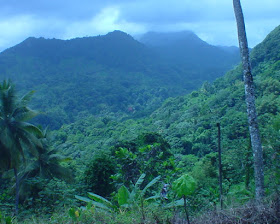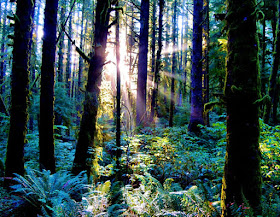 |
| Rain Forest Biomes |
Tropical forests exist in frost-free areas between the Tropic of Cancer and the Tropic of Capricorn. Temperatures range from warm to hot year-round. These forests are found in northern Australia, the East Indies, Southeast Asia, equatorial Africa, and parts of Central America and northern South America.
Rain forests are complicated tropical ecosystems with extremely high levels of biodiversity. Occupying only 6 percent of the earth’s surface, they contain at least 50 percent of the world’s known plant and animal species.
The rain forests are being destroyed at such an unprecedented rate, however, that if the trend continues, no sustainable tropical rain forests will remain by the middle of the twenty-first century.
  |
Tropical rain forests are the most complex ecosystems on earth, consisting of interacting systems of vegetation and animal species, all interdependent and coexisting in a concentrated cacophony of life. Because species found in one area may differ radically from those in another region only miles away, rain forests are individualistic and highly diversified.
The rain forests surrounding the Amazon basin in South America represent the last great contiguous expanse of tropical rain forest remaining in the world.
Containing at least 20 percent of the earth’s higher plant species and an equal percentage of the world’s birds, Amazonia is being systematically devastated by human actions. About 20 percent has already been destroyed, and the rate has accelerated. In the mid-1990’s about 14,000 acres were being cleared every day.
The environmental, economic, and social consequences of large-scale tropical deforestation are numerous and severe for the entire earth. The implications of losing the rain forests’ biodiversity are dire.
Moreover, rain forests act as giant solar-powered engines that pump water, nutrients, and carbon dioxide through the biosphere.Water captured by vegetation is returned to the atmosphere by evaporation and then to the forest as rain.
The forest also stores large quantities of water in the vines and roots of the plants, water that is slowly released to streams and rivers. When large tracts of rain forest are cleared, the system’s ability to store water decreases, disrupting the local climate and causing alternating periods of drought and floods.
Rain forests consist of lush, abundant growth, but the soil is deficient in nutrients and only marginally fertile. Although organic materials decompose rapidly inwarm, humid climates, heavy rains leach nutrients from the soil.
Plant life has adapted by rapidly ingesting nutrients as they become available; thus most nutrients are stored in the vegetation itself, not in the soil.
When the land is cleared for agriculture or livestock grazing, the necessary crop-sustaining nutrients are depleted within a few growing seasons. Rain-forest destruction also adversely impacts the environment and human life by reducing the conversion of atmospheric carbon dioxide into oxygen.
Food Resources
 |
| Sunrise in rain forest |
Tropical rain forests are important sources of genetic material for improving crop plants or breeding new varieties. As the population size of a species shrinks, genetic diversity shrinks in direct proportion because as a species diminishes in number, genes disappear even if the species survives.
A reduction of the gene pool renders a species less adaptable to changing environments and more susceptible to extinction. Future generations will be unable to benefit from currently unidentified but potentially useful properties of these species if their genetic diversity is extinguished.
Without periodic infusions of new germ plasm, crops bred specifically for humans, such as coffee, bananas, and cocoa, cannot continue to produce high yields at low cost.
As the products of generations of selective breeding, these crops continually require the amalgamation of new genetic material to maintain productivity and flavor, to counteract new diseases and insect strains, and to endure environmental stresses such as unusual cold or drought.
In recent decades, a number of important crops, including cocoa, coffee, bananas, and sugarcane, have been saved from viruses and other pathogens by being crossbred with wild species having naturally acquired resistance.
   |
Although crop diseases can be contained or eliminated by applying pesticides, the cost is more than many farmers can afford. It is much less expensive, and more environmentally benign, to find a resistant strain of the same species in the wild.
Future contributions from wild germ plasm, in addition to breeding new disease-resistant varieties of crops, might include the creation of hybrid perennial varieties of annual crops, eliminating the need for yearly plowing and sowing.
Another possibility may be new varieties of conventional crops which could survive in conditions or environments that are currently unsuitable, extending the plants’ cultivation range.
Rain forests also provide opportunities for humans to develop and cultivate entirely new crops. Many staples, such as rice, peanuts, yams, and pineapples, originated in ancient tropical forests. These staples are not necessarily the best possible sources of nutrition and protein; they were merely the crops most easily cultivated by Neolithic humans.
While temperate forests produce fewer than two dozen edible fruits, more than twenty-five hundred palatable fruits grow in the tropics.
Only about 10 percent of these are typically consumed, and only about one dozen are exported. The variety of fruits that Americans purchase from grocery stores is but a small fraction of those potentially available.
Because Americans consume an enormous quantity of sugar annually, there is a need for a sweetening agent lacking the potentially undesirable side effects of synthetic sweeteners.
Natural sweeteners found in common fruits are problematic because Americans already consume more of these than is healthy. However, a new class of nonfattening natural sweeteners made of protein compounds has been identified.
At least one thousand times sweeter than sucrose, and with no known detrimental side effects, these tropical sweeteners may prove a viable replacement for the sucrose commonly added to food items ranging from salad dressing to fish products.
Medicinal Plants
 |
| Rain forest medicinal plants |
Rain-forest plants contain a plethora of yet uninvestigated biodynamic compounds with undiscovered potential for use in modern medicine. Future generations may benefit from these substances only if the species containing them are preserved and studied.
Although the medicinal properties of plants have been known for at least thirty-five thousand years, modern science has reduced human dependence on medicinal plants. Nevertheless, approximately 50 percent of all U.S. prescription drugs contain substances of natural origin, and at least half of these contain active ingredients derived from plants.
Medicinal plants from the tropics aid modern pharmacologists in four ways. Plants may be used as a direct source of therapeutic drugs that cannot effectively be synthesized in the laboratory.
Plant extracts may become the starting point for more complex compounds. Derived substances can serve as “blueprints” for new synthetic compounds. Finally, plants may assist as taxonomic markers for uncovering new healing compounds.
Of the hundreds of thousands of plant species inhabiting the rain forests, only a small fraction have been identified and studied, and the potentially beneficial pharmacological properties of many of these are yet to be ascertained.
Endangered Biome
Although extinction is a natural process, tropical rain forests are disappearing at a rate four hundred times faster than during the recent geological past. One prominent and direct cause of the destruction of the rain forest in Amazonia is the production and transportation of oil.
The fragile rain forest environment is easily contaminated by leaks, spills, and the ejection of effluents during pumping operations. Of even greater environmental impact is the oil companies’ practice of building roads from inhabited areas to the well sites.
Pipelines are built along the roads to carry the oil out of the jungle, but unemployed urban residents often follow the roads into the jungle and become squatters on adjoining land. They clear a small section of rain forest, using the slash-and-burn method, to eke out a living as subsistence farmers.
Unfortunately, when the rain forest is gone, so are most of the nutrients needed for local agriculture; the land cannot sustain crops for long.
Then the farmers and their families must move on and claim more of the forest, regardless of the effects on the jungle or its native species. The tens of thousands of squatters engaging in this practice contribute to the rapid rate of rain-forest destruction.
Although aware of the problem, the governments of most South American oil-exporting countries have a strong incentive to underplay or ignore the negative impact of oil production in their rain forests: Their economies depend on oil, which is one of South America’s largest exports.
Ultimately the demand for oil, driven by high consumption rates in the industrialized nations of the Northern Hemisphere, particularly the United States, is one of the primary factors causing rain-forest destruction.